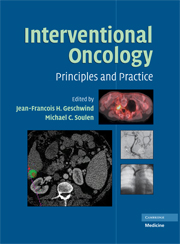Book contents
- Frontmatter
- Contents
- FOREWORD
- ACKNOWLEDGMENTS
- CONTRIBUTORS
- PART I PRINCIPLES OF ONCOLOGY
- PART II PRINCIPLES OF IMAGE-GUIDED THERAPIES
- PART III ORGAN-SPECIFIC CANCERS
- PART IV SPECIALIZED INTERVENTIONAL TECHNIQUES IN CANCER CARE
- 42 Vascular Access: Venous and Arterial Ports
- 43 Gastrointestinal Stenting
- 44 Diagnosis and Management of Superior Vena Cava Syndrome
- 45 Palliative Care and Symptom Management
- 46 Complications of Therapeutic Endovascular Procedures in Malignant Liver Diseases
- INDEX
- Plate section
- References
42 - Vascular Access: Venous and Arterial Ports
from PART IV - SPECIALIZED INTERVENTIONAL TECHNIQUES IN CANCER CARE
Published online by Cambridge University Press: 18 May 2010
- Frontmatter
- Contents
- FOREWORD
- ACKNOWLEDGMENTS
- CONTRIBUTORS
- PART I PRINCIPLES OF ONCOLOGY
- PART II PRINCIPLES OF IMAGE-GUIDED THERAPIES
- PART III ORGAN-SPECIFIC CANCERS
- PART IV SPECIALIZED INTERVENTIONAL TECHNIQUES IN CANCER CARE
- 42 Vascular Access: Venous and Arterial Ports
- 43 Gastrointestinal Stenting
- 44 Diagnosis and Management of Superior Vena Cava Syndrome
- 45 Palliative Care and Symptom Management
- 46 Complications of Therapeutic Endovascular Procedures in Malignant Liver Diseases
- INDEX
- Plate section
- References
Summary
Externalized central venous catheters and totally implantable central venous access port systems are widely used to improve venous access reliability in patients receiving prolonged courses of cytotoxic therapy, anti-infectious chemotherapy or long-term parenteral nutrition. Totally implantable venous access port systems have several advantages over externalized catheters, including reliable venous access, low incidence of infection, absence of maintenance and fewer restrictions on activities such as bathing and sports. Ports are usually inserted by surgeons, anesthesiologists or radiologists in order to gain direct access to the central circulation as well as the hepatic artery to deliver cytotoxic drug directly to the liver. At the current time, minimally invasive techniques provided by interventional radiologists allow placement of catheter or port systems for intra-arterial hepatic chemotherapy (IAHC) without the need for open surgery or repeated catheterization.
Other directed intra-arterial therapies have been used, namely in the pelvis, but will not be described in this chapter, which will deal with central venous catheter and port placement for hepatic intra-arterial therapy.
VENOUS PORTS
Description
These devices consist of a port made of titanium or plastic with a self-sealing septum, accessible by percutaneous needle puncture, and a radiopaque catheter usually made in a well-tolerated long-term substance – silicone or polyurethane. Most ports are single lumen, but there are others with two lumens for separate administration of incompatible drugs. The connection between the catheter and the port can either be sealed during the manufacturing process or made at the time of placement.
- Type
- Chapter
- Information
- Interventional OncologyPrinciples and Practice, pp. 533 - 543Publisher: Cambridge University PressPrint publication year: 2008



